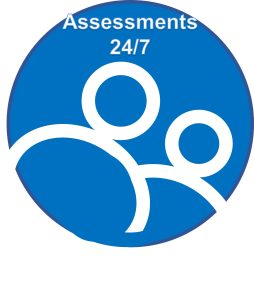Published with Permission from Assessments 24/7.

This is a Monday blog series; our regular coaching blog will be published on Thursday’s.
This blog series has explained the DISC styles, explored strengths and challenges, goals and fears, and reviewed how to identify style in person. Now identifying style on the phone is explained.
Dominance – High “D” Style
When speaking on the phone to a Dominance Style, treat her the same way as an in-person contact. Think of the ABC’s: Keep it abridged, brief, and concise. Prepare your delivery with the bottom line in mind: “The trend in your industry is toward computer-generated graphics. The research we’ve conducted with other typesetters in your area indicates increased profits of 20 to 30% over two years. I’d like to meet with you for 10 minutes to show you the numbers and see if this concept interests you.”
THEY WASTE NO TIME
It’s not unusual for a Dominance Style to call someone and, without saying hello, launch right into the conversation. “You’ve got to be kidding; the shipment delay will kill us . . . by the way, this is Jack.” When other people can’t keep up with them, or misread their cues and language, they may view them as incompetent.
On the telephone, it’s helpful to determine whether the person sends power signals. Dominance Styles want to pick the time and place to meet. They often speak in a sort of shorthand – concisely and pointedly, sometimes with few words – and sound cool, confident, and demanding. When Dominance Style Dennis phones, he says: “Janice? Dennis. Tony there?” Talking to him may feel like speaking to a machine or voice recognition system. The D style raises the concept of “brief and to-the-point” to another level. As commanding speakers who tend not to listen to others, they naturally want to direct the conversation toward their goals. Under stress, they can become defensive and aggressive, attacking others personally to show who’s in control. They dislike using touchy-feely, emotional terms, and prefer sensible thinking terminology. “I think we’ll implement this plan tomorrow,” or, “I think this discussion is over.”
Influence – High “I” Style
“What’s up?” or “What’s happening?” are the usual Influence Style opening lines. They are sometimes so animated that their gestures can be transmitted via the phone lines by their varied, emotional vocal inflections/intonations and their colorful choice of words that may tend toward exaggeration: “Really? That’s fantastic!” or “You have to be kidding me!” The phone can be a favorite toy that enables them to both prolong conversations and recharge themselves, especially when no one else is physically around. “I just called because I’m bored.” You may also detect background noise when you speak to individuals of this style. They sometimes put on the TV or radio just for the sound, visual stimulation, and activity. On the phone, Influence Styles speak rapidly and emotively. They are known to use “feeling” terms, rather than “thinking” terms like, “I feel that if we go through with this plan, the community will resent us as anti-environmentalists,” or, “I feel that I’ve contributed enough to this organization over the years to allow me to talk about this.”
SAY IT WITH FEELING
Typically, you’ll notice a wide range of vocal inflection and intonation and a tendency to want to know your reaction. The I style will ask, “Do you feel that way, too?” They liven up conversations with personal anecdotes and may keep you on the phone longer than you had anticipated. If you need to detach yourself from an extended monologue, try something like, “Well, Don, it’s been great talking with you. I’m really looking forward to our appointment on Monday!” If you say it with feeling, the Influence Style may already eagerly anticipate your meeting.
Steadiness – High “S” Style
“How are you?” or “I’m glad to hear from you again,” are typical Steadiness Style greetings. Like holiday ads from your favorite companies, their warmth can seem to transcend the limitations of the phone lines. Although they prefer more personal interactions with people, they will also settle for indirect contact – especially if the person is pleasant and non-threatening. They project this people-orientation easily, even by phone, and like to build a personal, first-name relationship with callers. Even if they don’t know you, they may say, ” Just call me Alice.” They may project a desire to know you personally or provide you with excellent service. They communicate with even vocal intonations to convey friendliness, comfort, and a sense of relaxation. Steadiness Styles tend to be naturals at listening to others’ ideas and feelings, whether on the phone or in person. They tend to be interested in the detailed, point-by-point description of what you did yesterday or the sequential pattern of how to complete a particular task. You’re probably talking to a high Steadiness Style if you notice warmth and genuine conversation, slower than average speech patterns, more moments of listening than of speaking, and references to actual, real-life experiences regarding either products or mutual acquaintances.
“I’LL CHECK ON THAT FOR YOU”
Steadiness Styles tend to express themselves in a somewhat tentative manner in both their face-to-face and telephone conversations. Even when confident with the answer, they will often attempt to get other perspectives before making a final decision. You’ll hear things like, “I’ll need to consult Mrs. Adams before I can make that decision,” or, “I’m not sure we can do that, but I’ll get back to you as soon as I find out.” As in other aspects of their lives, they often defer to the more human, proven way things have always been done. They typically feel more comfortable making decisions based on conferring with others rather than by themselves. “What do you think?”, “How do you feel?”, and “What do you recommend?” are all common questions this style will likely ask.
Conscientiousness – High “C” Style
“Good morning, Mr. Loomis. This is Jonathan Williams. You asked me to call back on Monday.” Formal greetings are one tip-off that you may be dealing with a Conscientiousness Style. Time-conscious individuals of this type often get to a task exactly when they say they will. Monday morning it is! In this example, the Conscientiousness Style also calls himself Jonathan, not Jon. Many people with this style call themselves by their given names, not by nicknames. It’s Elizabeth, Rebecca, Donald, and Peter, not Beth, Becca, Don, or Pete. Of course, there are exceptions; Jon may prove to be an effective and logical alternative for some Conscientiousness Styles, but this type seems less likely to tolerate what they perceive as “cute” nicknames, such as Jonny, Donny, or Becky. Remember, formality is more in alignment with this style.
“MAY I SPEAK WITH MR. HOLMES OR DR. BROTHERS?”
High C styles prefer brief, to-the-point telephone calls. Although they may not tell you, call them Mister or Ms. or Doctor, whatever their title happens to be, to build quick rapport. Conscientiousness Styles sometimes view jumping into a first-name basis as an invasion of privacy, so they deal with others more formally. If you think you’re talking to Sherlock Holmes or Bill Gates, chances are you’ve contacted a Conscientiousness Style. They typically hold their ground in stressful situations when they can maintain their position with concrete facts or evidence-based questions. They do this quietly and independently, by first avoiding others. Then they take on the problem in an orderly way, backed by research and relevant details.
“NEED TO KNOW” BASIS
They’re inclined to talk in structured, careful speech patterns, almost weighing their words as they say them. They tend to ask relevant questions and talk in a quiet, observant, and cautious way. Additionally, they may not volunteer much about their personal lives beyond the equivalent of name, rank, and serial number like, “I’m married with two children. We live in New York.” They prefer to keep the relationship formal, yet pleasant and business-like. Less can be more to a Conscientiousness Style – less conversation, less self-disclosure, and less verbal communication equal more comfort zone. Longer than average silences, especially when asked more private questions, may signal annoyance or reluctance. When this occurs, ask, “Am I getting too personal?” or “If I’m asking uncomfortable questions, could you let me know?” They may relax more if they think they have an out. Careful and correct, Conscientiousness Styles tend to express themselves in a somewhat tentative manner. “I’ll check on that and let you know tomorrow.” They may want to provide you with information so you can form your own conclusions. “I have a copy of the Governor’s report in my files. If I send it to you, perhaps you can find what you’re looking for.” Both of these approaches satisfy the Conscientiousness Styles’ need for caution and correctness. They may not want to get misquoted or, possibly, involved in the first place.
In the next blog identifying styles based on writing is explained.



